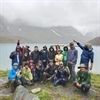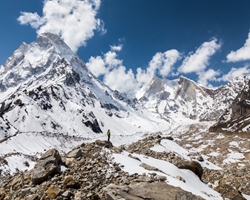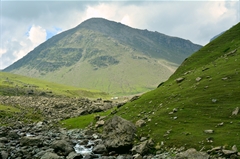
Tarsar Marsar Trek
A Shorter and Easier Alternative to the Kashmir Great Lakes Trek
Available Batches
Available Batches



Brief Description
Brief Itinerary
Detailed Itinerary
Day 1
Arrival at Aru (8,038 ft)-103 km drive
Report at Dal Lake gate number 1 at 12 noon. You will board a vehicle that takes you on a 2 hour drive to Aru, winding roads that take you through one of Kashmir’s famed tourist destinations of Pahalgam. Aru, our base camp for the Tarsar - Marsar trek, is another 12 kms ahead of Pahalgam. Stay overnight in tents at the open grassy campsite at Aru.
Day 2
Aru to Lidderwat (9.022 ft)-8 kms
We head out into the tree cover, visible at a distance from the campsite, leaving behind the green pen pastures. The trek starts with a gradual ascend for 2 to 3 hours through a beautiful pine forest trail. A short level walk along the Lidder river thereafter brings you to a tea stall. Another gradual ascend for 1 hour and you can see the Lidder forest rest house in sight. Cross a bridge and get to the Lidder campsite on the other side of the river.
Day 3
Lidderwat to Sekhwas (11,154 ft)-6 kms
The day’s trek starts with a moderate to steep ascent for 1 hour, followed by a level walk for another hour before we break for lunch, beside a gentle stream. We leave the tree line behind here, and ascend gradually for 1 more hour to reach the Shekwas campsite. From here one can get a good view of the surrounding mountains and the path heading up to the Tarsar lake. A short 1 hour hike from the Sekhwas campsite will take you to the small yet charming Jadar Lake. Return to Sekhwas and rest for the night.
Day 4
Sekhwas to Tarsar Lake (12,467 ft) -4 kms
A trek to the first of the lakes, Tarsar, is on the agenda today. We trek uphill from the Shekwas campsite, keeping the stream flowing down to our right. The views of the mountains get grander and more snow-clad peaks become visible all around us as we approach the Tarsar Lake. 2 hours of trekking and the beautiful lake reveals itself amidst imposing mountain ridges on 3 sides. A wonderful opportunity to camp next to the emerald blue waters of Tarsar Lake. Spend the day exploring the trails around the Tarsar Lake only to witness the grandeur of the lake surrounded by majestic mountains. The beauty of the lake is that it changes colors depending on the time of the day, season and the angle from which one looks at the lake. Retire for the night.
Day 5
Tarsar to Sundersar (12,960 ft) via Sonamous Pass (12,960 ft)- 6 km
Today, we have to cross the ridge which surrounds the Tarsar lake. An hour's climb to the top of the ridge and then we descend into the valley on the other side. The view of the valley leading to Zachmargi on the other side of the ridge is simply breathtaking. Upon descending into the valley, we walk along the stream which drains from Sundarsar. Set up camp at Sundarsar. Relax and admire the serene Sundersar Lake. Retire for the night.
Day 6
Visit Marsar Lake (12, 946 ft) and go to Homwas (11,500 ft) via Marsar ridge (13,201 ft)- 9 km
Walking around Sundersar, we trek up and over a saddle on a ridge located on the far side of the lake. Marsar is an hour's trek away from here. The trail takes you to a vantage point which gives you unparalleled views of the Marsar Lake, which is almost always engulfed under clouds and mist. The weather this height turns bad fast and is unpredictable. So, after soaking in the beauty of the lake and its surroundings, we turn back towards Zachmargi from Sundersar. From here instead of taking the Tarsar pass and reach Sekhwas, we trek for 2 to 3 hours to reach the campsite of Homwas. Retire for the night.
Day 7
Homwas to Aru (8038 ft) to Srinagar- 13 km. Drive 103 km to Srinagar
Today we depart the campsite of Homwas and take the same route we took at the beginning of the trek to reach Aru via Lidderwat. A two hours descent from Homwas will take you to Lidderwat and this time you can witness all the epic views that you had missed earlier on this trail. Passing through the pine forests of Lidderwat, we rest at Lidderwat for some time before resuming our trek to Aru which will take about 4 more hours to cover. Expect to reach Aru by 1600 hours and our vehicles will be waiting at Aru to drive you to Srinagar. Expect to reach Srinagar by 1900 hours.
What's Included
- Meals during the trek
- Forest Permits/Camping Charges/Permits, Trek Permit Fee/IMF Permission (Upto the amount charged for Indian nationals)
- Camping tents, Temp rated sleeping bags, mattress
- Safety Equipment includes static rescue rope, seat harness, carabiners, pulleys
- Mountaineering course certified Trek Leader with Wilderness Emergency Responder & Rescue. course from NIM Uttarkashi
- First Aid Certified Local guide, cook, helpers
- Porters or mules for carrying common luggage
What's Not Included
- Meals during road journeys
- Any kind of Insurance
- Any expense of personal nature
- Portage of personal backpack
- Any expense not specified in the inclusion list
- Transportation to and from Srinagar
Are you Eligible for this Adventure?
Located at an elevation of 4,000M, Tarsar Marsar Trek is a moderate level trek which for its difficulty level is suitable for anyone with some prior experience of high-altitudes.
BRS Level Required
TThis makes it mandatory for you tomhave high-altitude experience of preferably multiple treks marked at level 3 on the BRS. The altitude, the terrain, and the nature of the climb demand a certain level of endurance and a need for you to be aware of how your body reacts to the various features of the high-altitude environment.
If you do not know what level of BRS trek would suit you best, worry not! Fill out this Form:
we will send you a progression chart to help you comfortably get out of your comfort zone in order to level up and ultimately reach your highest potential in the big, bad world of outdoor adventure.
Packing List
This is a list of essential items for individuals doing the trek with Bikat Adventures. This list contains only those items which the participants are required to bring with them. The list excludes those items which are provided by Bikat Adventures on the trek. We have divided the items into five categories. All the items in the list are essential except for those marked as optional.
Trekking Gear
- Ruck sack bag with rain cover. Qty -1
- Day Pack Bag - Recommended for treks with summit day
- Head Torch with spare Batteries. Qty -1
- U V protection sunglasses. Qty -1 Here is how you can choose the best sunglasses for trekking.
- Water Bottles: 2 bottles of 1 liter each
Footwear
- Non-skid, deep treaded, high-ankle trekking shoes Qty -1
- Pair of light weight Slipper/Sandals Qty -1
Clothing
- Quick Dry Warm lower or Track Pants. Qty - 2
- Full sleeves T-shirts/ Sweatshirts. 1 for every 2 days of trekking
- Pair of thick woolen socks. 1 pair for every two days of trekking
- Thermal Body warmer Upper & Lower. Qty-1
- Undergarments. Qty - 1 for every day of trekking
- Warm jacket closed at wrist & neck .Qty-1
- Full sleeves sweater. Qty -1
- Rain wear ( Jacket & Pants ) . Qty-1
- Pair of waterproof, warm gloves. Qty-1
- Woolen cap. Qty-1
- Sun shielding Hat. Qty -1
Toiletries
- Personal toiletries kit (Small Towel, Toilet paper, paper soap, Bar soap, toothbrush, toothpaste, cold cream, etc.)
- Sun screen lotion small pack. Qty -1 Here is your Sun Protection 101 to stay safe in the bright sunny outdoors.
- Lip Balm small pack. Qty-1
Utensils
- Small size, Light weight & Leak proof lunch box. Qty-1
- Plate. Qty- 1
- Spoon.Qty-1
- Tea/Coffee (plastic) Mug.Qty-1
Miscellaneous
- Camera (Optional)
- Carry your medicines in plenty in case you have any specific ailment. Consult your doctor before joining the trek.
- Dry fruits, Nuts, Chocolate bars (Optional)
Frequently Asked Questions
Why Bikat?


Small Group Size
Our batch sizes are capped at 15 for smaller treks with the trek leader and trekker ratio of 1:8. This ratio, in our years of experience, has proven to deliver the best trekking experience for individuals as well as groups. Capping the size of the group ensures individual attention to each trekker so that no signs of distress or need during the trek go unnoticed. It also helps to form a more cohesive cohort with better group energy which helps define the rhythm and pace of days on the trek. As you go higher up on the BRS scale, since the stakes are higher, expeditions have an even smaller group size with the ratio of expedition leader to climber set at 1:2.


Qualified Trek Leaders
We follow a rigorous regime of hiring and training our experts in the field. Each trek leader is a certified mountaineer with years of experience in the field. In addition to their qualification, they also go through practical and situational training to tackle any and all kinds of sudden conditions that may present themselves on the ground. Being unpredictable is the core nature of the mountains but being ready for any circumstance as best as possible is a controllable asset that we try to nurture. Our field experts are also trained in basic medicine and first-aid response. Watch: Forerunners - The Making of A Trek Leader At Bikat Adventures


Guided Progression
Since Bikat Adventures is a learning-based organization, we help you climb up the ladder of difficulty within the sphere of outdoor adventure systematically. Our on-ground training modules are designed to handhold you through the upskilling process so that you are ready to take on bigger challenges.


Equipment Quality and Check
All the gear used on our treks and expeditions is tried and tested, maintained for good quality, and is overall top-notch in quality and condition. We are continually looking to obtain the best of everything there is in the market so as to ensure optimum safety.


Support Systems
Along with the staff you see on-ground, we have a team of superheroes working in the background to give you the best experience possible. Our background team also comprises local staff from each area who know the region best. Having local support helps with studying the area, pre-planning, execution, and in receiving timely support in case of emergencies in these remote locations.


Communication
Our on-field staff is in constant contact with our teams based in primary locations so as to eliminate any avoidable delay in reaching additional help and support when required. We try to use the best tools for communication available, including satellite phones, in regions where they are not restricted.
What our customers Say
Cancellation Policy
Cash refund
Cancellations up to 60 days prior to departure date
Between 60 days upto 30 days prior to departure date
Between 30 days upto 10 days prior to departure date
Less than 10 days prior to departure date
Voucher refund
Cancellations up to 30 days prior to departure date
Between 30 days upto 15 days prior to departure date
Between 15 days upto 10 days prior to departure date
Less 10 days prior to departure date
- Cash refund is applicable only in case of bookings made without using any promotional offer code or Cancellation Vouchers or Discounts
- This is only a brief of cancellation terms. For finer details please refer Detailed Cancellation Policy.
Blog Posts


Similar Adventures

Hampta Pass Trek
An Enchanting Cross-Over from Manali to Spiti
Himachal
5 Days
BRS 4
4200 m

Buran Ghati Trek
Trek with the most thrilling rappelling experience
Himachal
8 Days
BRS 4
4575 m

Gaumukh Tapovan Trek
Not just a trek but a journey to the source of River Ganga
Uttarakhand
8 days
BRS 4
4460 m































